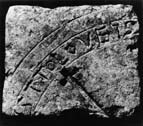Select a site alphabetically from the choices shown in the box below. Alternatively, browse sculptural examples using the Forward/Back buttons.
Chapters for this volume, along with copies of original in-text images, are available here.
Object type: Architectural feature (sundial)[1]
Measurements: H. 20 cm (8 in) W. 24 cm (9.5 in) D. 9 cm (3.5 in)
Stone type: [Lincolnshire limestone]
Plate numbers in printed volume: Ill. 358
Corpus volume reference: Vol 5 p. 258-259
(There may be more views or larger images available for this item. Click on the thumbnail image to view.)
The back of the rectangular stone and its top edge are quite smoothly dressed and look as if they are original faces. The left and bottom edges are roughly dressed, perhaps at a time of reuse. The right edge is broken.
The face of the stone bears incised decoration showing that it was part of a sundial. Arcs of three concentric circles remain, very shallowly incised; the outer border is left blank and the inner field is filled with an inscription. The letters, which measure between 2.5 and 3 cm in height, are clearly legible capitals set with their feet towards the centre. The text reads:
The top of the letter before the first S can be seen at the broken edge of the stone, and is probably part of an I. The lettering is incised with a flattish bottom to some of the strokes; there is neither word division nor any trace of punctuation.
The central field contains one complete radiating line or tide-mark, cut as a sharp-sided groove of rectangular section approximately 1 cm deep and terminating in a cross with its upper arm of type A1 and its side arms, cut a little shallower, of type B6. The edge of a second line lies at 40–45 degrees clockwise to it.
(This entry incorporates a transcription of the inscription by John Higgitt and his specialist comments.)
This is part of a well-executed sundial of some architectural pretension. Though none now survives, the tide-marks may have been designed for inlay. Letters set around the arc of a circle with their feet facing towards the centre are likely to have formed part of a completely circular dial (cf. Aldbrough 1 in Lang 1991, 123). The angle between the two surviving radiating lines suggests that the complete dial contained eight radiating lines. That is, it would nominally have displayed the octaval system of time division; though, since only the lower half of the circle would have been functional when set vertically, the 45 degree angles would need to be bisected to get divisions in approximately the right place (cf. Orpington 1 in Tweddle et al. 1995, 148). Nevertheless, the alternative suggestion that the dial was a hanging semicircle only, is made improbable by the consequence that the inscription would be entirely upside down. Projection of the tide-mark lines to the point of intersection gives the central field a radius about 15.5 cm or diameter about 31 cm.
As is common with sundials, the inscription may have conveyed information about a constructional phase or architectural campaign (cf. Higgitt 1991, 46–7). It apparently formed part of a text of the form –[CRI]ST TO LOVE 7 S–, that is '...to the glory of [Christ] and [?St]...'. The inscription at Lincoln St Mary-le-Wigford 6 deploys a similar formula. Okasha (1985) notes that the dial is carefully incised and inscribed, which is more characteristic of Anglo-Saxon sundials than of the mass-clocks and scratch dials of the later medieval period. That at Weaverthorpe church, Yorkshire ER, is one of the latest, combining com-parably careful workmanship and a text; it probably dates to the early twelfth century. Out of a small group of pre-Conquest inscribed sundials which includes those at Great Edstone, Kirkdale and Orpington (all of the tenth and eleventh centuries), the Stow fragment is most similar to that from Aldbrough, Yorkshire ER. This is circular and is divided into eight sectors of approximately 45 degrees; the resemblance extends to the setting of a text in Old English in the space between two concentric circles with the feet of the letters facing towards the centre (Lang 1991, 123–4). By Okasha's assessment, the linguistic evidence of the inscription suggests an early post-Conquest rather than a pre-Conquest date, i.e. either later eleventh or twelfth century. The local analogies for the mixed form of cross that terminates the dial's radiating lines tally with this assessment.
John Higgitt notes that the capitals of the inscription are somewhat irregular in size and execution. There are no unusual forms. The two Os are a little smaller than the surrounding letters; and the second O is slightly pointed at the base. As far as a short fragment of lettering like this can be judged, it belongs with the late pre-Conquest tradition of capitals, as does the use of the Tironian 7 sign for Old English and. It is unlikely to have been executed more than a few decades after the Conquest. At Stow this is a period of major architectural works, with campaigns c. 1050, c. 1090, and again in the mid twelfth century. This dial is evidently therefore a substantial survival from the first or perhaps more probably the second of these architectural schemes (cf. Stow 10–11).



